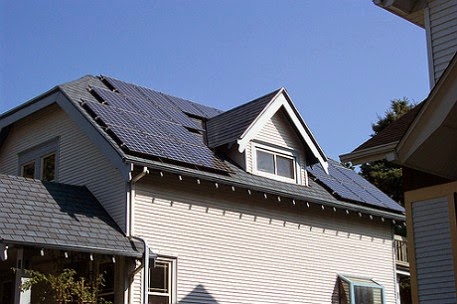
by jboullion | Jan 16, 2015 | Net Metering, Uncategorized
In the last three years, several Wisconsin utilities have proposed changes to their net metering service in an effort to reduce the value proposition of solar generation for host customers. One way to accomplish this objective is to dramatically shrink the duration of the netting period. In Wisconsin several utilities have sought permission to reconcile output and consumption on a monthly basis. Twice in the last two years, a majority on Wisconsin’s Pubic Service Commission have signed off on utility requests to limit the netting period to the monthly billing period, We Energies being the latest to receive approval to impose monthly true-ups.
As the article from Midwest Energy News’ Kari Lydersen below demonstrates, the greater the output from a PV array relative to the host customer’s consumption, the higher the likelihood that a portion of that system’s production will be compensated at a substantially reduced rate. Depending on the utility, that lower rate can be 75% less than the retail energy rate offset. This policy is particularly damaging to residential and small business solar producers, due to strong seasonal swings in both system output and consumption.
In Wisconsin, solar ‘new math’ could equal big impacts
Posted on 01/16/2015 by Kari Lydersen
 |
Solar panels on a home near Milwaukee.
(Photo by mjmonty via Creative Commons) |
For tourists, the “shoulder seasons” in the spring and fall are times to get cheap deals in ski resorts or beach towns that cater to summer and winter crowds.
For people with solar power on their homes, these seasons are when their solar installations are most likely to be producing more energy than the home actually needs. These “shoulder months,” as RENEW Wisconsin Policy and Program Director Michael Vickerman frames it, are at the crux of one of the ways solar power is under attack in Wisconsin.
The Wisconsin Public Service Commission recently approved three controversial rate cases proposed by We Energies, Wisconsin Public Service Corporation (WPS) and Madison Gas & Electric, which all will make it much less favorable or feasible to install solar panels on a home or small business.
We Energies, the most significant case, includes a provision that will change how the utility compensates consumers for sending energy back to the grid, by changing from annual to monthly “true-up” net metering calculations.
This may sound like an arcane modification. But Vickerman and other solar advocates say it means people will be compensated drastically less for the energy they send back to the grid during the spring and fall, and they are likely to build smaller solar installations as a result.
Unless an expected legal challenge to the Public Service Commission decision is successful, the true-up change will take effect in January 2016. WPS has done its calculations on a monthly basis since a 2013 rate case (docket number 6690-UR-122 on the commission’s website).
“It definitely is not reflective of best practices to switch from annual to monthly” true-ups, said Sara Baldwin Auck, regulatory program director of the Interstate Renewable Energy Council (IREC), which publishes an annual report called “Freeing the Grid” scoring states’ net metering policies.
“Net metering policies are a compilation of multiple pieces, they all add up to favorable [or unfavorable] conditions and terms for the customers who are seeking to invest in onsite renewable energy and take more control of their energy future and energy bills. It’s a little tough to say whether the true-up issue is the lynchpin, but I will definitely say that this issue ranks higher than others as far as contributing to the overall best practices.”
The math
Typically, at the end of the year utilities tally up how much energy a customer has used and how much they have sent back to the grid from their solar installations. Then the customers are either charged or compensated for the difference, or the energy they have “banked” may be put toward the coming year’s usage.
When someone produces more energy than they have used, there’s the question of how much to pay them for that energy sent back to the grid. This is where net metering policies defined by different state laws or determined by different utilities can vary significantly.
The customer with solar panels can be compensated at the retail rate – the cost they would have paid for electricity at that time; or the “avoided cost” rate, the amount the utility estimates it saved by not having to provide that amount of power to other consumers on the grid. The rate may also be determined through a formula based on several market factors.
Retail and avoided cost rates are significantly different. Avoided cost rates for Wisconsin utilities are 3 to 4 cents per kWh, while retail rates are around 11 to 14 cents per kWh.
When a solar installation produces less energy than a home uses during the true-up period, the way surplus energy is compensated is irrelevant, since there is none. But when someone is sending significant solar energy to the grid, different rates of compensation can add up.
That’s where the shoulder seasons become important. Most Americans use their highest amounts of electricity in the summer, with air conditioners running. Winter also usually means high electricity use, with more lights on when the sun sets early and electricity sometimes used for heating the home or heating water. In the spring and fall, by contrast, household electricity use tends to be lower. That’s when solar installations are most likely to send more electricity back to the grid than the home uses.
If net electricity consumption and generation is all tallied up at the end of a year, people essentially get to “use” their springtime solar power in the summer or winter when their demand is higher. But if the balances are tallied every month, consumers will often end up getting low avoided cost rate payments for their surplus energy during the shoulder seasons, then buying more electricity at higher retail rates in summer and winter.
We Energies spokesman Brian Manthey said, “Monthly net metering more accurately and more fairly values distributed generation by crediting on-peak use at the on-peak rates and crediting summer generation at typically higher summer-based rates.”
“To set the buyback rate at something higher than avoided cost for customer-generated energy would set an inappropriate price signal and would be unfair to customers without their own generation,” Manthey continued.
How much does it matter?
Vickerman said surplus energy payment and true-up policies are typically figured in when someone decides what size solar installation to put on their home. If they won’t be paid much for unused energy, they may choose a smaller installation…meaning less clean energy on the grid.
Vickerman made these points in testimony before the Wisconsin Public Service Commission in 2013 regarding WPS’s change to monthly true-ups. He noted that companies who advise customers on installing solar use sophisticated “solar math” to decide what size system is most financially efficient, and the true-up period is an important consideration in that equation.
Vickerman gave an example of a 4,500-4,900 kWh system in Green Bay. That would seem a good fit for a home using 5,000 kWh per year. But given typical monthly fluctuations, based on widely accepted models, he estimated that household would have to sell 561 kWh per year back to the utility at the lower avoided cost prices.
That would represent a loss of about $55 under monthly true-ups compared to annual calculations. That would increase by 10 percent the time it would take the solar system to pay for itself in energy savings. Faced with that situation, Vickerman said, a customer might choose a smaller solar array.
“You need to look at all the pieces,” of a net metering policy, said Baldwin Auck. “One element can really have a domino effect on whether that policy is ultimately effective in encouraging people to install these systems.”
The national scene
Baldwin Auck said that 22 states have “some form of annual true-up.” The “ideal scenario” for net metering, she noted, is “indefinite rollover,” where the excess energy someone has sent to the grid is perpetually credited to their account in a situation akin to a meter literally running backwards.
In California, state law says that a customer cannot be required to true-up more frequently than once a year. However some utilities offer customers the option to true-up monthly, saying it helps them avoid “surprise” charges once an annual bill is due.
PG&E in California, for example, calculates net metering on an annual basis, and at that time pays customers an annual rate of 4 cents per kWh for the surplus energy. Southern California Edison allows customers to receive a check for surplus energy at the end of the year or to roll over their credit into the next year’s billing cycle.
California received an A grade for net metering policies in the 2015 Freeing the Grid report. California also has more friendly solar policies on other fronts, for example only solar installations of 20 kW or less typically qualify for net metering in Wisconsin, whereas California utilities accept installations up to 1 MW.
Illinois, Michigan, Iowa, Indiana and Minnesota all got B’s for net metering policies in Freeing the Grid, and Ohio got an A.
“The monthly true-up is much less common, and there is a strong correlation between states that have received an A or B grade on the scorecard, and annual true-ups,” Baldwin Auck said.
The value of electricity
Clean energy groups plan to challenge various aspects of the We Energies rate case. First they must file an administrative challenge with the Public Service Commission. If the commission denies that
appeal, they can file a lawsuit in state circuit court.
“We will ask the commission to reconsider, though we have a pretty good idea what the commissioner will say,” said Vickerman. “It’s a process we have to go through.”
The commission’s approval of the MG&E rate case is also likely to be challenged. However the MG&E case does not change the true-up period.
Another utility, Alliant Energy/Wisconsin Power and Light does not have a full rate case pending, but it recently went through a smaller proceeding before the Public Service Commission. Wisconsin Power and Light already trued-up customers with solar monthly. But they paid the retail rate rather than the avoided cost rate, so the monthly calculations raised no concerns. A change which took effect January 1 (docket number 6680-FR-107)) means that now Wisconsin Power and Light pays separate retail and avoided-cost rates.
“They were already doing the net calculations every month, but it didn’t matter when every kilowatt hour got the same credit,” said Vickerman. “Now they’re switching from a one-tier to a two-tier structure, and suddenly it matters.”
Renew Wisconsin challenged the Wisconsin PSC change, and ultimately came to a settlement that allows more customers to continue for a longer time grandfathered in under the old system. The settlement means the utility increased from five to 10 years the time grandfathered-in solar operates under the old system. And the settlement meant solar installed up until December 31, 2014 is grandfathered in, as opposed to the utility’s proposal of July 2014.
“We’re not happy with that, but on the other hand it could be much worse,” said Vickerman of the settlement.
Baldwin Auck said that in the debates over true-up policies and surplus energy rates, she hopes people don’t lose sight of the forest for the trees.
With a solar installation “You’re reducing onsite consumption, and on top of that giving energy back to the grid,” she said. “The credit a customer receives for that energy should be reflective of the full value of that electricity.”
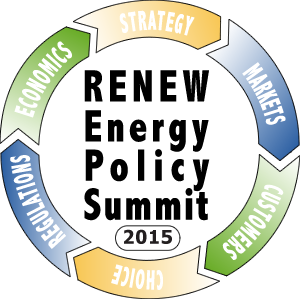
by jboullion | Jan 6, 2015 | Uncategorized

(Madison) – At its fourth annual Energy Policy Summit, RENEW Wisconsin will present awards to businesses and individuals whose achievements and vision helped lift Wisconsin’s renewable energy marketplace to new heights in 2014.
Titled “Unlocking the Clean Energy Transition,” RENEW’s summit is set for January 9, 2015, and will take place at UW-Madison’s Union South.
“The people and companies we will recognize this Friday are making a lasting impression on Wisconsin’s renewable energy landscape,” said RENEW Wisconsin Executive Director Tyler Huebner. “As Wisconsin’s preeminent clean energy organization, RENEW benefits greatly from their pioneering innovations and hard work, which help prepare the ground for broader policy advances.”
“We at RENEW are honored to have the opportunity to work closely with these award winners and take inspiration from their ongoing commitment to advancing clean energy here,” Huebner said.
A list of award categories and recipients appears below.
Energy Independent Enterprise of the Year – Gundersen Health System, La Crosse – For becoming the first large health care network in the nation to offset 100% of its electricity usage with its own sources of clean energy.
Renewable Energy Business of the Year – Eland Electric Corporation, Green Bay – For planning and building in 2014 nearly one megawatt of rooftop solar generation in the Fox Valley/Northeast Wisconsin region.
Renewable Energy Champion of the Year – Matt Neumann, SunVest Solar, Pewaukee – For outstanding public advocacy on behalf of regulatory policies and reforms that would allow renewable energy contractors to provide mainstream financing options for their customers.
Renewable Energy Grassroots Activists of the Year – Steve and Ellen Terwilliger, Eau Claire – For organizing and co-hosting, along with Chippewa Valley Technical College, the Solar Power Wisconsin Affordable Energy Conference, a new outreach event that attracted nearly 200 people to Eau Claire in November 2014 to learn more about solar energy.
For more information on the 2015 program agenda, speakers, and registration, please visit: http://www.renewwisconsin.org/2015_Summit/
-END-
RENEW Wisconsin leads and accelerates the transformation to Wisconsin’s renewable energy future through advocacy, education, and collaboration. More information on RENEW’s Web site at www.renewwisconsin.org.
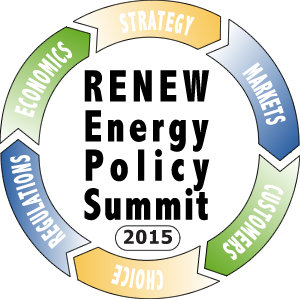
by jboullion | Jan 5, 2015 | Uncategorized
 For immediate release
For immediate release
January 5, 2015
More information
Tyler Huebner, Executive Director
608.255.4044
tyler.huebner@renewwisconsin.org
Renewable Projects Selected for RENEW’s 2014 Honor Roll
Newest Wisconsin Generators Powered by Water, Cow Manure, and the Sun
(Madison) – At its fourth annual Energy Policy Summit, RENEW Wisconsin will recognize the largest, and the most innovative, renewable generation projects built in Wisconsin in 2014. Titled “Unlocking the Clean Energy Transition,” RENEW’s summit will take place January 9, 2015, at UW-Madison’s Union South.
The 16 clean energy projects inducted into RENEW’s Honor Roll added 5.92 megawatts (MW) of new generating capacity in Wisconsin. Of that total, the two hydropower projects–Badger Hydro and Angelo Dam–account for slightly more than 3 MW. In the biogas category, Gundersen Health System recently energized its 600-kilowatt Sunny Side Digester installation northeast of Sun Prairie.
The other 13 generators, accounting for 2.27 MW, are solar powered. Many of the solar projects fit the definition of Community Solar, either involving a single array sponsored by customer subscriptions (a/k/a solar gardens) or a single contractor installing solar electric systems in a particular neighborhood.
Combined, the projects will provide enough electricity to power the equivalent usage of about 2,600 Wisconsin homes.
Perhaps representative of a shift in attitudes on distributed renewable generation, two of the projects to be highlighted are owned by electric providers. One project, Kaukauna Utilities’ Badger Hydro, involved reconstructing and upgrading an existing unit, resulting in a generating capacity increase of nearly 3 MW. Barron Electric Cooperative owns its 100 kW solar garden outright.
In addition, electric providers sponsored the construction of four solar gardens in Wisconsin, three of which—Vernon, St. Croix, and Barron–are supported by self-selecting customers. In exchange for their up-front contributions to the array, these customers receive a credit on their monthly bills. Over the course of their subscription period, typically 15 years long, these customers should receive a financial return in the neighborhood of 4%.
In addition to the utility-sponsored solar gardens, this year’s Honor Roll includes two neighborhood-based Community Solar initiatives organized by a single installer. In Black River Falls, Ho-Chunk Nation supplied 45 solar electric systems installed by PV Systems, Inc., and serving residential households, while in the Bay View neighborhood in Milwaukee, Arch Electric energized 38 individually owned solar electric systems there.
Also to be honored are eight solar installations serving manufacturers, faith communities, a brewery, an airport maintenance facility and a public museum.
“The Energy Policy Summit is a fitting venue to honor the people and organizations that embraced the vision of energy self-sufficiency and job creation, and brought these ideas to fruition,” said RENEW Wisconsin’s Executive Director Tyler Huebner.
“Their solar, hydro, and bioenergy installations created jobs, reduced the flow of imported fossil fuels into Wisconsin, and demonstrated responsible environmental stewardship. They truly deserve the recognition, as well as everyone’s appreciation,” Huebner said.
A list of the projects that earned a spot on RENEW’s 2014 Honor Roll appears on page 3.
For more information on the 2015 program agenda, speakers, and registration, please visit:
http://www.renewwisconsin.org/2015_Summit/
-END-
RENEW Wisconsin leads and accelerates the transformation to Wisconsin’s renewable energy future through advocacy, education, and collaboration. More information on RENEW’s Web site at www.renewwisconsin.org.
Distributed
Renewable Generation in Wisconsin
RENEW Wisconsin – 2014
Honor Roll
|
Biogas
|
|
Installation
|
Owner
|
County
of Location
|
Capacity
(in kW)
|
Installer/
Contractor
|
|
Sunny
Side Biodigester
|
Gundersen
Health Systems
|
Dane
|
600
|
U.S.
Biogas
|
|
Hydro
|
|
Badger
|
Kaukauna
Utilities
|
Outagamie
|
7,000
(2,800 new)
|
Boldt
Construction
|
|
Angelo
Dam
|
Western
Technical College
|
Monroe
|
205
|
Lunda
Construction
|
|
Solar
– Utility
|
|
Dairyland
Power Cooperative
|
Clean
Energy Collective
|
Vernon
|
517
|
Vernon
Electric
|
|
Solar
– Community
|
|
Vernon
Electric Cooperative
|
Clean
Energy Collective
|
Vernon
|
305
|
Vernon
Electric
|
|
Ho-Chunk
Nation (Black River Falls)
|
Ho-Chunk
Nation
|
Jackson
|
158
(45 systems)
|
PV
Systems, Inc.
|
|
Bay
View Neighborhood (MKE Shines)
|
Bay
View homeowners
|
Milwaukee
|
136
(38 systems)
|
Arch
Electric
|
|
St.
Croix Electric Cooperative
|
NRCO
|
St.
Croix
|
103
|
|
|
Barron
Electric Cooperative
|
Barron
Electric
|
Barron
|
100
|
Carr
Creek
|
|
Solar
– Customer-Owned
|
|
AMI
|
Brown
|
175
|
Eland
Electric
|
|
Holy
Wisdom Monastery
Benedictine
Women of Madison
|
Dane
|
145
(125 new)
|
H&H
Solar
|
|
Griffin
Industries
|
Brown
|
113
|
Eland
Electric
|
|
Astro
Industries
|
Brown
|
113
|
Eland
Electric
|
|
Sisters
of St. Francis of the Holy Cross
|
Brown
|
112
|
Eland
Electric
|
|
Dane
County Regional Airport
|
Dane
|
100
|
Energy
Concepts
|
|
Ale
Asylum
|
Dane
|
100
|
SunPeak
|
|
Milwaukee
Public Museum
|
Milwaukee
|
98
|
Convergence
Energy/Arch Electric
|
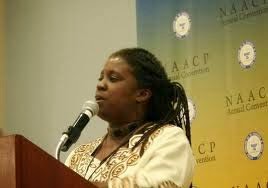
by jboullion | Dec 30, 2014 | Uncategorized
Speech to integrate Clean Energy & Civil Rights
Oftentimes in life, unforeseen things come up that require changes, and that has happened for one of our Summit keynote speakers. Jigar Shah sends his regrets but he is no longer able to attend the Summit to deliver the closing keynote address.
We have used this opportunity to bring a new voice on clean energy to our Summit audience, that of the NAACP. Director of Environmental & Climate Justice, Jacqui Patterson, will explain what “Just Energy” means to the NAACP and why they are supportive of renewable energy, and distributed energy, to achieve those goals.
Below is our press release, sent out today, explaining more about her upcoming talk! We welcome Jacqui to Wisconsin and look forward to continuing to build the renewable energy movement in Wisconsin with her leadership.
For Immediate Release
December 30, 2014
More Information, Please Contact:
Tyler Huebner
608-255-4044 ext 1
tyler.huebner@renewwisconsin.org
 |
| Jacqueline Patterson, NAACP |
RENEW Wisconsin is pleased to announce that Jacqueline
(“Jacqui”) Patterson, Director for the NAACP Environmental and Climate Justice
Program, will be the closing keynote speaker for its fourth annual Renewable
Energy Policy Summit in January. The
event, titled “Unlocking the Clean Energy Transition,” will take place
Friday, January 9th, 2015 at UW-Madison’s Union South.
The lead author of NAACP’s 2014 report titled “Just Energy
Policies: Reducing Pollution and Creating Jobs,” Patterson will make a powerful
case for a clean energy transition that will lead Wisconsin to a healthier and
more affordable future. Her vision embraces clean energy not only as a pathway
to reduced pollution but also as a driver for creating and distributing new
jobs and business opportunities throughout the state.
The Just Energies report assesses states on five different
criteria: Renewable Portfolio Standards,
Energy Efficiency Resource Standards, Net Metering Standards, Local Hire
Provisions, and Minority Business Enterprise Provisions. The report also examines the potential for
each state to become a leader in clean energy.
Ms. Patterson will take the place of clean energy visionary
Jigar Shah, who had to cancel due to unforeseen circumstances.
For more information on the 2015 Renewable Energy Summit
agenda, speakers, and registration, please visit
www.renewwisconsin.org/2015_Summit/.
-END-
RENEW
Wisconsin leads and accelerates the transformation to Wisconsin’s renewable
energy future through advocacy, education, and collaboration. More information
on RENEW’s web site at www.renewwisconsin.org.

by jboullion | Dec 23, 2014 | Uncategorized
 Here are some updates on Focus on Energy renewable energy programs, from recent meetings of the Public Service Commission and meetings RENEW has had with Focus on Energy staff.
Here are some updates on Focus on Energy renewable energy programs, from recent meetings of the Public Service Commission and meetings RENEW has had with Focus on Energy staff.
Residential Rewards funding for renewable energy projects (solar PV and geothermal)
All projects applied for by October 28th, 2014, will be receiving their cash-back reward for solar PV. It is expected that the $450,000 budget was exceeded by $200,000 or more, but the projects will be funded, and the extra funds will not be taken from other renewables funding.
RECIP Update
A project with a $400,000 grant in 2014 fell through, and the Commission directed that funding to be carried over to 2015 and used for renewable energy projects.
Focus on Energy staff are anticipating issuing a RECIP RFP in early 2015. The budget levels, from RENEW’s understanding, are that approximately $1.2 million should be available for RECIP projects that will be installed in 2015.
We are working with Focus on Energy staff to determine a RECIP schedule for 2015 and 2016 so that all installers know the schedule that is forthcoming and can plan accordingly.
2015 & 2016 Funding Update
For 2015, we expect:
– $1.2 million in RECIP, for projects installed in 2015
– $450,000 in residential rewards
– up to $2.5 million in new revolving loan program (more details below)
For 2016, we expect:
– About $3.0 million in RECIP projects that will be installed in 2016
– $450,000 in residential rewards
– $2.5 million in revolving loan program funding
The Commission will review the rebate and loan funding in mid-2016, to determine funding allocations for 2017 and 2018.
$6 million digester program for smaller farms updateThis program is still being scoped out. RENEW is gathering some feedback from digester developers, and at this point we anticipate Focus staff working to get more information from digester companies and farmers on the barriers to adopting digesters and what information, research, or implementation needs exist to bring digester technology down to smaller farms. As more details emerge and opportunities for feedback become available, RENEW will be in touch.
Loan Program Update
As of this writing, we understand the Focus on Energy staff is planning, at the high level, the following for the new loan program:
– Loan program will be largely based off Iowa’s “Alternative Energy Revolving Loan Program”
– Loans under $50k would be 1st come, 1st served, and would open in January
– Loans for over $50k would be completed through a quarterly RFP, and would start in March/April
– $2.5 million per year would be lent out for each of 2015, 2016, 2017, and 2018.
– Lending partners – any lender can become part of the program. Lenders will do the financial / credit check review of the applicants.
We will be working to get more details on this program and to make sure the industry is updated and has ample opportunity to ask questions and get them answered.

by jboullion | Dec 22, 2014 | Uncategorized
Check out Mike Ivey’s Interview of Ale Asylum co-owner Otto Dilba and the photos of Ale Asylum’s new 100 kW solar electric system. Ale Asylum’s array will be one of many 2014 renewable projects recognized at our upcoming Energy Policy Summit, titled Unlocking the Clean Energy Transition.
Register for the 2015 Policy Summit Here!
 |
| Photo Courtesy of Ale Asylum |
Ale Asylum co-owner Otto Dilba has always credited partner Dean Coffey for cooking up Hopalicious, Bedlam and the other recipes that have turned their brewery into one of Madison’s most-loved business start-ups.
“He’s the beer expert … I’m just the words guy,” said the self-effacing Dilba when the pair
launched their brewery in a vacant warehouse near the MATC campus in 2005.
A native of Tomahawk, Dilba, 40, earned a degree in marketing from the University of Wisconsin-Madison in 1998 and worked for the hipster
Planet Propaganda advertising firm before plunging into the beer business with Coffey. The two met while working at the now defunct
Angelic Brewing Co. on West Johnson Street.
Today, Ale Asylum is housed in an $8 million, 45,000-square-foot brewery and tasting room at
2102 Pankratz St. near the Dane County Regional Airport. By design, anyone flying in or out of Madison travels past the brewery.
With 45 employees,
Ale Asylum will produce over 20,000 barrels of beer in 2014 and has launched distribution into the Illinois markets of Chicago, Rockford and Champaign. By comparison, the New Glarus Brewing Company sold 146,000 barrels last year, making it the 17th largest craft brewery in the nation, but distributes only in Wisconsin.
This month, Ale Asylum is partnering with
SunPeak to install a 100 kilowatt photovoltaic solar system atop their building. Helped with a $75,000 grant through the state
Focus on Energy program, Ale Asylum is looking both to lower its carbon footprint and cut its monthly bills with Madison Gas & Electric in half.
Ale Asylum has already made sustainability efforts including offering spent grain to area farmers for animal feed, using heat from the brewing process for its tasting room and letting cold winter air keep its walk-in cooler at the proper temperature.
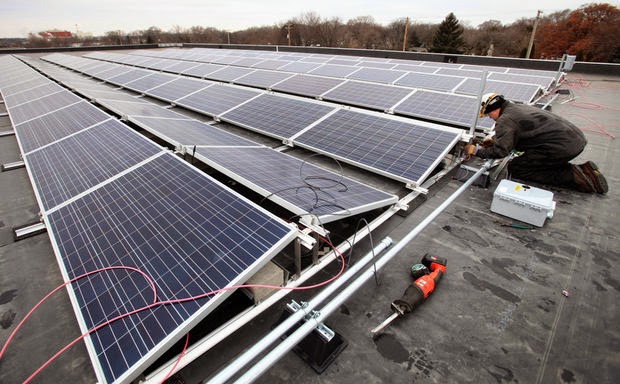 |
| Photo Courtesy of The CapTimes |
The old line is that beer is cheap to make but expensive to move. Where do energy costs figure into the whole equation?
That is a very interesting question. For any business, salaries are the biggest expense but after that for us it’s probably energy and ingredients. We wanted to add solar when we first opened in 2012 but the finances didn’t make sense. But the people at SunPeak helped guide us through the process of applying for the Focus on Energy grants which made it possible.
Is the idea then just to lower energy costs or make a statement about sustainability while appealing to customers who care about the environment?
We don’t spend our time worrying about what will appeal to anyone. That is a bad business practice no matter what business you are in. We just do what we do and try to do it right and hopefully people will attach themselves to that.
But on the solar, did you think, ‘Hey, people who like craft beer will like us even more because we are trying to shrink our carbon footprint?’
Again, don’t care. To go into the thinking that it’s a good marketing gimmick is a terrible way to approach it. Solar is just one of the myriad of things that can help reduce our carbon footprint and our reliance on fossil fuels. We are told our monthly bills from MGE will go down by about half when we figure in all the incentives but this will only cover about 20 percent of our energy use.
Ok, let’s talk about the beer. How is the expansion into Illinois going?
It’s going great. Over the course of the first 12 months we’re at about 50,000 cases which is right around the mark we were looking to hit. When I say cases, that is somewhere around 2,250 barrels or about 10 percent of our overall production which will be about 20,000 or 21,000 barrels this year.
What is the production capacity at Ale Asylum if you were to run 24-7?
If we were to max out the building we could do about 50,000 barrels a year. But we have a south facing wall we could knock down if we wanted to get even bigger. So we are not going anywhere. Ever. I just don’t want to have to pick up and move that many tons of equipment again.
Any thoughts on the corporatization of the craft brewing industry? I see that Anheuser-Busch just bought 10 Barrel in Bend, Oregon, and earlier they bought Goose Island in Chicago. I’m sure this must be a big topic within the industry.
Our overriding philosophy is we would never let anyone else diaper our babies. When we were planning for our new location, I remember talking after a meeting with the head of the Madison Planning Commission and we were having a beer and sort of shooting the s— and he asked “So what happens when Budweiser comes knocking?” and I said, “We’ll tell them to f— off.” That kind of sums it up.
Listen, for the guys at
10 Barrel or Goose Island, they’re good people doing good things. But they have their own philosophy and we have ours. We would stop distributing and just become a brew pub before we would ever sell out to Bud.
What Budweiser and these big breweries used to do was buy these small breweries and bury them in their lineup and crush them and destroy them. I guess they have figured out that it is not a business plan that works. So hopefully now they buy them and then let them do what they do, in addition to offering them the distribution channels and tutelage they didn’t have before. I hope that is the case and I think it is.
But does that tarnish the craft brewing scene? You might say ‘I used to drink Goose Island but I don’t anymore because they are owned by AB.’
I think that comes down to an individual perspective so it depends on the consumer. Some won’t care. Some will have that exact thought process. Personally I don’t think it should matter whether the product is beer or horseshoes. If it’s good, it’s good. I mean at Goose Island, it’s still local people, working hard, doing their thing, caring about what they do. It’s not about Budweiser coming in and saying “You need to do this.” It’s more about keeping their hands off and giving them the tools and more access than they had before. For them, maybe that isn’t a bad thing.
Unfortunately some people make the mistake of thinking that just because you get larger you care less about the things that matter most. Look, we don’t care any less about quality. It’s always been about the beer. Every day of every week we are looking to get better. To suggest that because we are at 20,000 barrels instead of 2,000 barrels we care any less is just wrong.
Where do you see the industry going then? Craft beer is 7 or 8 percent of the market now. Will we continue to see the growth or do you see it leveling out at some point?
It’s grown every year for 30 years and never had a down year and it’s not going to because once you develop a taste for craft beer you are not ever going to go back to the swill. You just don’t. It’s like when you were in college having your bologna sandwiches and you discovered for just a little bit more money you could get fresh deli meat. When was the last time you bought bologna?
Life is too short to drink cheap beer, right?
I agree 100 percent on that one. If I have to pay for it, I want to enjoy it. But seriously, it’s never going to go down because the trough we are pulling people from — Budweiser, Miller and Coors — is enormous, it’s huge. They lose a 10th of one percent and that is hundreds of thousands of barrels spread across the craft beer industry. So there is so much room for growth.
Finally, I see you are going to roll out a new seasonal each month in addition to your regular lineup.
We’ll start in mid-January with the first one. It’s called Velveteen Habit. It’s an IPA and a lot of people have described us as the “hopheads” brewery so I figure they will enjoy an IPA from us. We’ll try not to mess it up.
Read more: http://host.madison.com/news/local/writers/mike_ivey/q-a-otto-dilba-says-ale-asylum-will-never-sell/article_ba73ea84-b5ba-582a-a71d-a730d95b460f.html#ixzz3MfbHh3g2








